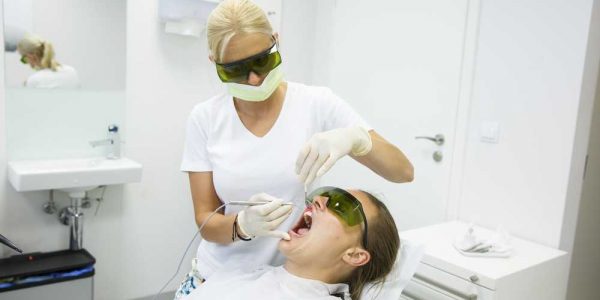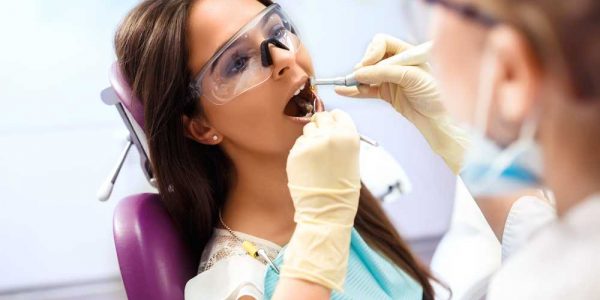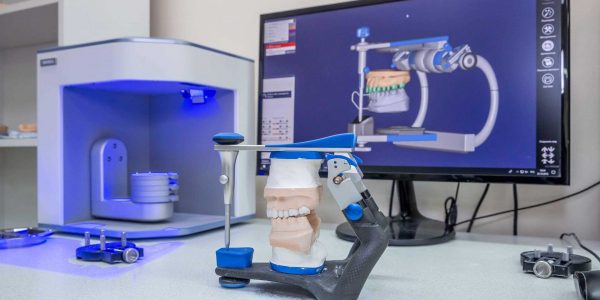
Dental practice depends on excellent customer referrals. Patients are looking for dental practices that use advanced technologies like Cad Cam in dentistry and offer unparalleled customer service by reducing waiting and operation times.
Cad Cam dentistry has existed for the last 20 years but has primarily been relegated to dentistry laboratories. In the previous decade, patients have seen widespread adoption of technology in the office sphere.
The technology enables the dentist to make dental digital impressions through digital scanners and use 3-D printing to make molds. Cad Cam in dentistry is fast, hygienic, and eco-friendly compared to traditional dental practice methods.
What is Cad Cam Dentistry
CAD stands for Computer-aided design, while CAD means computer-aided manufacturing. The technology lets your dentist take a digital image of your teeth and gums. This is then fed to computer software, which sends this information to a milling machine. The technology is highly accurate, with little chance of error.
The technology was introduced in the 1980s but relegated to lab use. At that time, the Cad cam dentistry equipment was cumbersome and inefficient. With time, advancements in technology led to the adoption of Cad Cam technologies in the dentist chairside.
Before the technology is introduced, restorations would take a week. A prosthesis would be created when the patient visits the dentist, and they would wear it temporarily for a week until the laboratory processes the final crowns. With the introduction of technology, patients could get restorations on the same day.
In-Office CAD/CAM Digital Technologies
As stated above, Cad Cam technologies were relegated to the laboratories for a long time. Introducing modern dental digital scanners, milling machines, and 3-D printing meant that the equipment used was less bulky, leading to wide-scale adoption in dentistry offices. Many dental practices use the equipment to reduce delivery timelines, increase efficiency, improve customer relations, and improve their bottom line as they can now serve more customers.
Dental digital scanners
Before the age of technology, dentists would use old-fashioned impression trays to make dental impressions. However, this technique took time. Dental Digital scanners are used for 3-D digital impressions of your teeth. Dental Digital scanners capture both your soft and hard tissues.
Digital scanners are fast and hygienic. Scanners capture images at a rate of thousands of frames per second. Patients prefer this due to the comfort it provides. The dentist can check the impressions on their computer screens and make changes where necessary. The risk of any distortions is also eliminated, unlike traditional impressions. The impressions created by the dental digital scanner are then sent to the laboratory, where a mold is digitally produced. Cad Cam in dentistry provides an eco-friendly way for dental surgeries.
Dental milling
In the process, the Cad-Cam software will create molds of ceramic or composite resin that closely resembles the tooth to restore. The first part involves taking a digital image of the tooth and the surrounding areas — a Dental digital scanner. The image is then fed to the Cad software for adjustments and modifications. A visual restoration image is created after this. The image is then sent to the milling machines for creation. Stains and glazes are fired into the milled mold to correct the monochromatic appearance.
Dental 3-D printing
Regarding dental 3-D printing, three technologies are used: digital light processing, stereolithography, and material jetting. Each has its own set of pros and cons. Note that the quality of equipment used will influence the final product.
We will begin with stereolithography printing. Here, a laser beam is used on a vat of liquid resin. Some areas of the resin will be solidified, helping to create the mold. You can use this technology on a wide range of materials, and it provides the best finish of the three. Stereolithography printers are amongst the most affordable in-cab cam dentistry labs.
Digital light processing uses a digital projector instead of a laser, similar to stereolithography. While you get a simple workflow with the DLP printers, they are more expensive than stereolithography printers.
The technique used in material jetting is similar to your standard inkjet printer, but the liquid resin can be used instead of ink in this case. Material jetting is increasingly losing its popularity amongst dentists due to its high cost of production.
When selecting a 3D printer for your dental office to ensure that the printer delivers on accuracy, this may force you to spend extra for a quality printer.
Dental Furnaces
Dental ceramic furnaces are used in cam dentistry to produce ceramic dental items like bridges, crowns, inlays, and onlays. The furnaces operate at high temperatures, which helps harden the molds. Technological advances have led to the development of dental furnaces with digital controls. This means you can use it with your cad cam software.
CAD/CAM Software
Cad Cam dentistry software completes scanning, processing, and digitally manufacturing impressionsare. With the Cad cam software, you can draw, design, and manipulate geometric shapes to develop a dental model.
The software uses wireframe geometry to adjust circles, lines, and points. The process of Cad will produce 3-D shapes that you can feed to the CAM for the manufacturing side of the method. CAM converts the CAD shapes into a language that makes it easier for the machines to use during manufacturing.
When you install your CAM software, you will need to wait for the applications to define the cutting paths for the tools used to shape a model to its ideal shape: the software influences what needs to be cut and its speed. During this time, the CAM operator may add specific tools and configure them with the CAM software. Operators use 3D tool paths, hole drilling, and 2D tool paths.
CAD/CAM Advantages and Disadvantages
If you have not decided to invest in Cad Cam dentistry technologies, you need to check out our pros and cons before deciding. Note the performance of the machinery purchased will depend on the manufacturer. Some equipment offers unrivaled accuracy but is more expensive. Accuracy also depends on the skills and training the dental practitioner suggests.
Advantages
Improved customer relations
Patients often take time off work to visit their dentist for a restoration. Time is of the essence. Cad cam in dentistry enables digital impressions and printing that saves time. The digital impressions are error-free, which means you will not have customers returning to your office because of an ill-fitting impression.
Fast restorations
The process used in cad cam is fast and efficient. Once you capture a digital impression, you send it to your computer for modifications and final production through the mill. This process enables patients to get same-day restorations. All these processes are completed in-house; you do not need to outsource.
Hygiene
A Dental digital scanner scans 3-D images of the teeth and gums. You can use the scanner for multiple patients without worrying about contamination.
Reduced overall costs
The initial costs for setting up a Cad cam in dentistry can be huge, but when you look at the Return on Investment (ROI), there is an increased value addition. In the long run, the cost of doing a restoration, compared to traditional models, is lower. The lab cost also decreases because you need less staff for restorations.
Precise fabrications
Cad Cam software ensures precise measurements when creating molds. Depending on the quality of the milling equipment, you can create error-free crowns. This saves you money and time perfecting a crown made with traditional methods. There is a vast difference in the final product when you use Cad cam milling machines.
Disadvantages
High initial cost
The cost of implementing a cad cam system can be high. It would help if you also allocated some time for training. Dentists who do not have a high traffic inflow will find it hard to recoup the initial investment.
Aesthetic drawbacks
The final mold lacks a natural appearance, leading to people using cad cam dentistry to use superficial staining to change this appearance. You can notice the difference between restorations done through Cad cam and those done through hand-layered porcelain restorations.
Quality of machines
Even though one uses Cad Cam software, there can be variations to the crowns and bridges created. There are instances where you have ill-fitting crowns. The reason for this could be the milling machines’ quality and the user’s experience. More expensive machines are created to achieve higher accuracy levels than others.
Top Cad Cam Machine for Dental Lab
Here is the Cad Cam Dentistry list used in both the dental laboratory and the dental office.
1. Planmeca FIT
The system integrates a digital scanner, 3D-designs through Cad and Cam, and milling into one streamlined process. It is a system that recommends chairside operations. A dentist can perform same-day operations and thus increase their efficiency. You can integrate your Planmeca PlanScan scanner with any Planmeca dental unit.
The scanner enables live scans, and with audio capabilities, the dentist can confirm to their staff that the procedure has worked. The scanner has three removable tips, a cradle, and a power cable. You can mount the scanner or use the weighted base to comfortably place it on flat surfaces. Other benefits of using the Planmeca intraoral scanner include:
- Ease of use and accuracy
- Powder-free scanning
- Autoclavable tip enhances infection control
- Windows and STL support
For your 3-D designs, the system uses the Planmeca PlanCAD software. Once you complete it, you can send the finished designs or outsourced files to the Planmeca PlanMill. The milling machine accepts STL file formats.
One of the key benefits of using the Planmeca system is that you can perform restorations without the patient leaving the office. The number of restorations you can perform on any given day also increases, and this helps boost your bottom line.
For milling, you have the Planmeca Planmill 40S and the 30S. The Planmill 40S is designed on open technology and enables easy integration with Cad Cam dentistry software. It has a user-friendly interface with digital controls. You also get wireless connectivity, and this makes the milling process ultra-fast. To ensure accuracy, the mill comes with dual spindles.
The Planmill 30S has a 360-degree spindle, ensuring the best accuracy while maintaining cost efficiency. Just like the 40S, it builds on open-source technology. With a milling time of 16-18 minutes, you can perform more restorations and increase your margins. You have wizards on the control system to guide you through milling.
Once you decide to go with the software, you will train on using the software and equipment; besides the training, you also get ongoing support for the Cad cam dentistry equipment.
The system offers remarkable accuracy, and you can share your experiences on Planmeca Romexis Cloud. The therapeutic process is fast, which counts for a memorable experience for you and your clientele.
2. CEREC MC XL
CEREC MC XL, designed by Sirona, is their new addition to their milling products. With twice the milling resolution than the previous model, the CEREC MC XL is rated to reduce the milling process with enhanced accuracy. For image acquisition, you can use the Sirona AC blue cam. You should be able to scan the surrounding enamel for restorations in just a few seconds.
The images can then be fed to the CEREC MC XL mill. This is a wet mill that is small enough for office-based restorations. You can easily switch from grinding to milling at the touch of a button.
You can perform indirect porcelain dental restoration using Cad Cam dentistry software. The milling equipment saves your patient time because restorations can be completed on the same day instead of taking several weeks in traditional milling plans. You can use the CEREC MC XL for inlays, outlays, partial and complete crowns, temporary bridges, and veneers. The milling process is estimated to take an average of 4 minutes.
Is it worth the investment in Dental CAD/CAM Technology?
The initial outlay for setting up Cad Cam dentistry can be huge. You may also decide whether to lease the equipment or purchase new equipment. While leasing gives you a reduced initial investment when starting, it could be more expensive in the long run when you tally all the monthly costs.
You also end up not owning the equipment, and if you get hold of it, you discover that it is outdated. Cad Cam technologies have become cheaper with technological advancements, and many dentistry practices opt for new equipment instead of leasing.
While the initial costs for purchasing the equipment can be hefty overall in the long term, it offers a good return on investment. Customer experience is enhanced due to same-day restorations. You can perform more daily restorations with Cad Cam technology, which will help boost your margins.
Modern milling machines are more accurate and error-free. The machine reduces the costs associated with wrong crowns. With a milling machine, you do not need to outsource the milling process to laboratories because you can now do it in-house. You will only need a separate office when you are doing all-ceramic bridges. It would be best to have a second office to insert the bridge. The associated costs for the cad cam technology pass to insurance policies, which means you do not need to charge your patients more.
Any dentist who is serious about expanding their dental practice must invest in Cad Cam technology. It is fast, error-free, and enhances customer experience, increasing sales.
Conclusion
Cad cam dentistry technology has existed for 20 years, but adoption has increased in the previous decade. The initial costs for purchasing equipment can be prohibitive for dentistry practices that have a low traffic, but for the rest, they may be able to recoup their prices within a few years.
The benefits of having a cad cam technology are numerous. Your customers get to enjoy fast and efficient services with same-day restorations. Once you have gone through the training, you should start seeing an increase in foot flow in your dental practice because you can perform more daily restorations.
You also enjoy unrivaled accuracy due to the preciseness of the cad cam software. Accuracy is, however, dependent on the quality of machines purchased. Dental digital scanners are more hygienic than traditional methods of making impressions. You can easily modify the resulting image on your cad software. Overall, we should see an increase in the adoption of CAD cam technology as innovations increase, and the purchase cost should come down.






